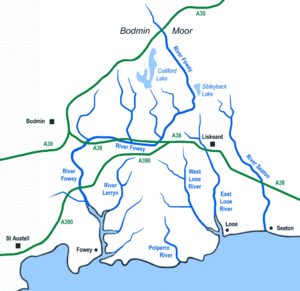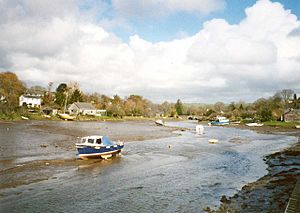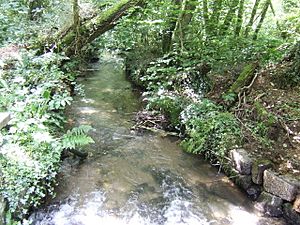River Lerryn facts for kids
The River Lerryn is a beautiful river located in eastern Cornwall, England. It is a smaller river that flows into a larger one, the River Fowey. Rivers that flow into bigger rivers or lakes are called tributaries. The River Lerryn is the biggest tributary that joins the Fowey's estuary. An estuary is where a river meets the sea, and the water mixes.
The river's water level changes with the ocean tides up to the village of Lerryn. This means that when the sea tide is high, the river water also rises.
Contents
About the River Lerryn
The area around the River Lerryn is mostly countryside. This includes open areas with low-growing plants like heather, known as heathland. There are also moorlands, which are wild, open areas, and rough pastures where animals might graze.
Where Does the River Lerryn Begin?
The River Lerryn starts at a place called Fairy Cross. This spot is on the southern side of Bodmin Moor. Bodmin Moor is a large area of granite moorland in Cornwall. From Fairy Cross, the river flows towards the south-southwest. It continues until it reaches the Fowey estuary.
Special Places Along the River
The land that the River Lerryn flows through is called its catchment area. This area is very important for nature. It includes four special places known as Sites of Special Scientific Interest (SSSIs). These are protected areas because they have rare plants, animals, or geological features. One of these important SSSIs is called Redlake Meadows & Hoggs Moor.
The lower parts of the river's catchment area have many trees. You can find broadleaf woodlands, which have trees that lose their leaves in autumn. There are also coniferous woodlands with trees like pines and firs, and mixed woodlands with both types.
What Does the Name "Lerryn" Mean?
The name of the River Lerryn comes from the Cornish language. The earliest times we see its name written down were in 1289. Back then, it was spelled "Leryan" or "Lerion."
In modern Cornish, the river's name would be "Dowr Leryon." This means "river of floods." The nearby village of Lerryn is also named after this river.




